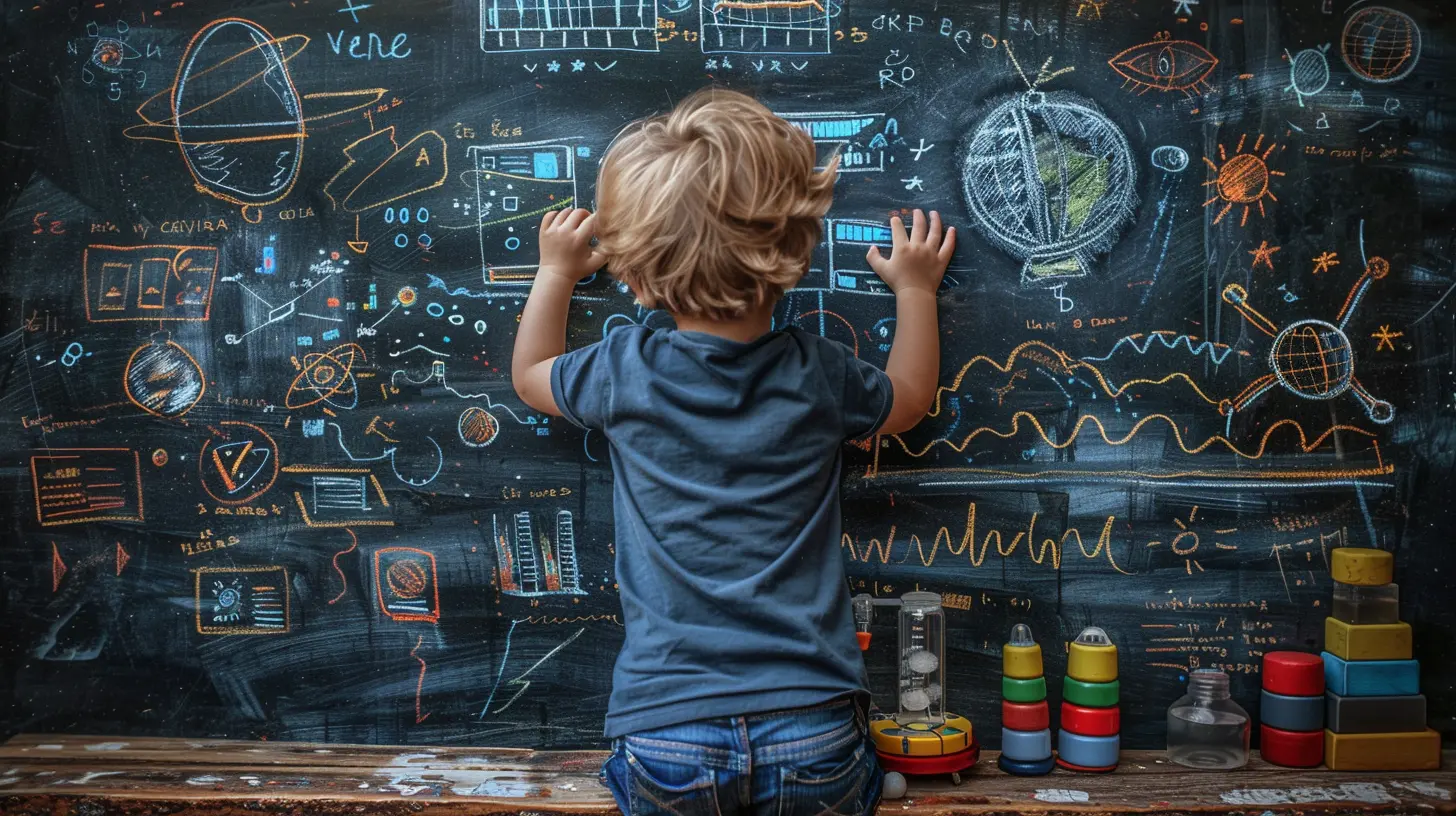Inspiring Young Innovators: The Role of STEM in Early Childhood Education
28 December 2024
Let’s face it – the world is changing faster than ever before. The rise of technology, artificial intelligence, and automation has transformed industries in ways we could have never imagined. So, how do we prepare the next generation for a future filled with innovation, creativity, and problem-solving? The answer lies in STEM education, and more specifically, starting STEM early in childhood.
When we talk about STEM, it stands for Science, Technology, Engineering, and Mathematics. But it’s not just about numbers and equations. STEM is the foundation that encourages critical thinking, curiosity, and a deeper understanding of the world. And the best part? It’s never too early to introduce kids to the magic of STEM. The earlier we spark that curiosity, the more potential we unlock.
In this article, we’ll explore why exposing kids to STEM at a young age is crucial, how it fosters innovation, and how early childhood education can lay the groundwork for tomorrow's trailblazers.
Why Is STEM Important in Early Childhood Education?
Building Blocks of a Creative Mind
Children are naturally curious. They want to know how things work, why things happen, and what’s possible. By introducing STEM concepts early on, we're tapping into that innate curiosity and giving it direction. STEM is like a playground for the brain – it lets children explore and experiment in ways that other subjects might not.Think about it: when a child builds a tower with blocks, they're not just playing. They're learning about balance, weight distribution, and even basic engineering principles. When they ask, "Why is the sky blue?" it's an opportunity to introduce them to the wonders of science. These “small” moments can nurture a lifelong love for learning.
Developing Critical Thinking and Problem-Solving Skills
STEM helps children look at the world differently. Instead of accepting things as they are, they learn to question, experiment, and find solutions. These are the same skills that innovators and inventors use every day. By encouraging young children to think critically and solve problems from an early age, we're equipping them with the tools they’ll need to tackle challenges later in life.Plus, STEM activities often involve trial and error. When a child’s bridge collapses or their experiment doesn’t work, they learn resilience. They learn that failure isn’t the end but an opportunity to try again in a different way. This mindset is a key component of innovation – it’s what drives inventors to keep going even when things don’t work out the first time.
The Role of STEM in Fostering Innovation
Nurturing Curiosity and Creativity
Let’s get one thing straight: STEM is not just about memorizing formulas or crunching numbers. It’s about creativity. Many of the world’s greatest innovations were born from individuals who thought outside the box. STEM encourages kids to do just that.In STEM, there’s rarely one “right” answer. Instead, there’s a world of possibilities waiting to be explored. For example, when a child builds a robot, they’re not just following instructions – they’re learning how to think creatively, solve problems, and improve their design. They’re being innovators without even realizing it.
Encouraging Hands-On Learning
STEM education is incredibly hands-on. In a world where learning can sometimes feel abstract, STEM brings concepts to life. Whether it’s building a bridge out of popsicle sticks, coding a simple game, or planting seeds to observe growth, STEM activities connect theory with real-world applications.Hands-on learning also helps children retain information better. When they actively participate in a project, they’re more likely to understand the concepts behind it. This not only fosters a deeper understanding of STEM subjects but also makes learning exciting and engaging.
The Benefits of STEM in Early Childhood Development
Enhancing Cognitive Skills
STEM education directly influences the development of cognitive skills in children. During early childhood, kids' brains are like sponges – they absorb everything around them. Engaging in STEM activities helps strengthen their cognitive abilities, such as:- Memory: Remembering steps in an experiment or the function of certain tools.
- Attention to detail: Noticing small changes in their projects or experiments.
- Logical reasoning: Understanding cause and effect, patterns, and sequences.
- Spatial awareness: Visualizing how pieces fit together in puzzles or models.
These cognitive skills are crucial, not just for STEM subjects, but for all areas of life. Whether they’re solving a math problem or figuring out how to share toys with a friend, kids benefit from the mental tools STEM provides.
Promoting Collaboration and Teamwork
Many STEM activities are collaborative, teaching children how to work together to solve problems. Whether it's building a structure together or conducting a group experiment, children learn the importance of teamwork. They also learn how to communicate their ideas clearly and listen to others.Collaboration is a major part of innovation in the real world, too. Think about companies like Apple or SpaceX – their success is driven by teams of people working together to bring ideas to life. By teaching children how to collaborate early on, we’re giving them a head start on developing skills that will be essential in their future careers.
Preparing for Future Careers
We live in a world that’s increasingly driven by technology. Jobs in STEM fields are growing faster than in any other sector. In fact, according to the U.S. Bureau of Labor Statistics, STEM jobs are projected to grow by 8% between 2019 and 2029, compared to 3.7% for non-STEM jobs.By introducing children to STEM early on, we’re preparing them for the future job market. Even if they don’t end up pursuing a career in a traditional STEM field, the skills they gain – problem-solving, critical thinking, creativity – will be valuable in any profession.
How to Incorporate STEM in Early Childhood Education
Encourage Exploration Through Play
The best way to introduce young children to STEM is through play. Children learn best when they’re having fun, so integrate STEM concepts into their natural play activities. For example:- Building blocks: Teach simple engineering by encouraging kids to build structures.
- Legos and puzzles: These help with problem-solving and spatial awareness.
- Outdoor exploration: Let kids explore nature and ask questions about the world around them.
- Water play: Use different containers to explore concepts like volume and buoyancy.
These activities don’t need to be complicated or expensive. The goal is to make learning fun and interactive.
Use Simple, Everyday Materials
You don’t need fancy equipment to teach STEM. In fact, some of the best learning tools are things you already have around the house. Everyday items like cardboard boxes, plastic bottles, and kitchen utensils can all become part of a STEM activity.For example, use a cardboard tube as a ramp and let children experiment with rolling different objects down it. Ask them questions like: "Which object rolls faster?" or "What happens if we tilt the ramp higher?" These simple activities can spark curiosity and encourage problem-solving.
Incorporate Technology in a Balanced Way
Technology is a big part of STEM, but it's important to use it in a balanced and age-appropriate way. There are plenty of educational apps and games that introduce children to coding, math, and science concepts in a fun and engaging way. However, it’s essential to balance screen time with hands-on activities, so children get a well-rounded learning experience.The Role of Parents and Educators in Supporting STEM
Parents as STEM Advocates
Parents play a key role in fostering a love for STEM in their children. You don’t need to be a scientist or a mathematician to support STEM learning at home. Encourage your child’s curiosity by asking questions, exploring together, and providing opportunities for hands-on learning.For instance, if your child asks, "Why do leaves change color in the fall?" take the opportunity to explore the concept of photosynthesis together. You don’t need to know all the answers – part of the fun is discovering them together!
Educators as STEM Champions
Teachers are often the first to introduce children to STEM concepts in a formal setting. By incorporating STEM into everyday lessons, educators can help children make connections between the classroom and the real world. Whether it's through science experiments, math games, or introducing basic computer coding, teachers have the power to ignite a passion for STEM in their students.Final Thoughts: The Power of Early STEM Education
In a rapidly changing world, one thing is certain – the innovators of tomorrow will be those who can think critically, solve complex problems, and approach challenges with creativity and resilience. By introducing STEM in early childhood education, we're not just preparing children for future careers. We're giving them the tools they need to navigate a world full of possibilities.Remember, STEM isn’t just about creating the next Einstein or Marie Curie. It’s about inspiring young minds to explore, question, and innovate. And who knows? The child building a Lego tower today could be designing skyscrapers tomorrow!
all images in this post were generated using AI tools
Category:
Stem EducationAuthor:

Monica O`Neal
Discussion
rate this article
18 comments
Presley McQuade
Nurturing young minds through STEM in early childhood lays the foundation for innovative thinking. By fostering curiosity and problem-solving skills, we equip the next generation to navigate complexities and drive transformative change in an ever-evolving world.
April 7, 2025 at 4:34 AM

Monica O`Neal
Absolutely! Early STEM education is crucial for developing critical thinking and creativity in young minds, preparing them to tackle future challenges.
Troy Summers
“Sure, STEM is great, but let’s not pretend kids need a lab coat to spark creativity! Innovation starts with curiosity. Let them play, explore, and question everything. The next Einstein might just be building a fort, not calculating derivatives!”
March 26, 2025 at 9:28 PM

Monica O`Neal
Absolutely! Curiosity and exploration are key to creativity. STEM can enhance these experiences, but play is fundamental in nurturing innovative minds.
Dixie Kirkpatrick
What an uplifting read! It’s amazing how fostering STEM in early childhood can spark creativity and innovation in young minds. Let’s nurture the inventors of tomorrow! 🌟🔧✨
February 17, 2025 at 1:11 PM

Monica O`Neal
Thank you! I completely agree—nurturing creativity through STEM in early childhood is vital for shaping the innovators of the future! 🌟
Eden Weber
Who knew building rockets could start in preschool? 🚀✨ Inspiring young innovators with STEM is like planting seeds for a garden of creativity—watch out world, here come the mini Einsteins ready to shine!" 🌱🔧
February 2, 2025 at 5:03 AM

Monica O`Neal
Absolutely! Early exposure to STEM fosters creativity and critical thinking in young minds, paving the way for the innovators of tomorrow. 🌟
Haze McGeehan
This article beautifully highlights the importance of STEM in early education, inspiring creativity and critical thinking in our youngest learners. Thank you!
January 28, 2025 at 8:44 PM

Monica O`Neal
Thank you for your kind words! I'm glad you found the article inspiring and that it emphasizes the vital role of STEM in fostering creativity and critical thinking in young learners.
Nicholas Barron
Great insights on fostering innovation in young minds! STEM is indeed crucial for early childhood development.
January 23, 2025 at 5:16 AM

Monica O`Neal
Thank you! I'm glad you found the insights valuable. STEM is vital for nurturing creativity and problem-solving in young learners!
Zara Cooper
Empowering young minds through STEM fosters creativity and critical thinking, laying a strong foundation for future innovators ready to tackle tomorrow's challenges.
January 15, 2025 at 1:18 PM

Monica O`Neal
Thank you! Empowering young minds through STEM is indeed crucial for nurturing creativity and critical thinking, essential for tomorrow’s innovators.
Melissa Schultz
This article beautifully highlights the essential role of STEM in early childhood education, fostering creativity and critical thinking skills. Inspiring young innovators today is crucial for a brighter tomorrow!
January 8, 2025 at 5:08 AM

Monica O`Neal
Thank you for your kind words! I'm glad you found the article highlights the importance of STEM in nurturing young innovators.
Fatima McWhorter
This article highlights the crucial role of STEM in early childhood education, emphasizing its potential to cultivate critical thinking and creativity. By fostering a supportive environment, we can inspire the next generation of innovative problem solvers.
January 4, 2025 at 8:49 PM

Monica O`Neal
Thank you for your insightful comment! I completely agree that nurturing creativity and critical thinking through STEM is essential for developing future innovators.
Giovanna Ford
Exciting to see how early STEM exposure fuels creativity and innovation in young minds!
January 2, 2025 at 3:27 AM

Monica O`Neal
Thank you! Early STEM exposure indeed sparks creativity and lays a strong foundation for future innovation.
Nyx Elliott
Empowering young minds through STEM fosters creativity and curiosity, paving the way for future innovators. Let's inspire the next generation!
December 31, 2024 at 12:36 PM

Monica O`Neal
Thank you for your insightful comment! Empowering young minds through STEM is indeed vital for nurturing creativity and innovation. Let's continue to inspire and support the next generation!
Antonia Fuller
STEM in early education? Absolutely! Let’s unleash the creative geniuses before they trade innovation for mundane—because who needs another corporate drone?
December 31, 2024 at 3:26 AM

Monica O`Neal
Absolutely! Early STEM education fosters creativity and innovation, empowering the next generation to think outside the box and challenge the status quo.
Paxton McTier
STEM: Sparking tiny genius sparks!
December 30, 2024 at 1:51 PM

Monica O`Neal
Thank you! We believe that nurturing these tiny geniuses through STEM education can ignite their creativity and problem-solving skills from a young age!
Madalyn McCallum
Great insights on fostering innovation through early STEM education!
December 30, 2024 at 3:17 AM

Monica O`Neal
Thank you! I'm glad you found the insights valuable. Early STEM education is crucial for nurturing future innovators!
Lindsey Carter
STEM in early childhood fosters creativity and critical thinking, essential for nurturing the next generation of innovators.
December 29, 2024 at 11:28 AM

Monica O`Neal
Absolutely! Early STEM education lays a crucial foundation for creativity and critical thinking, empowering young minds to become the innovators of tomorrow.
Charlotte Cummings
This article beautifully highlights the importance of introducing STEM concepts in early childhood education. By nurturing curiosity and creativity, we empower future generations to become innovative thinkers. It's inspiring to see how these foundational skills can shape not just careers, but also problem-solving abilities for life. Thank you for sharing!
December 28, 2024 at 8:28 PM

Monica O`Neal
Thank you for your thoughtful comment! I'm glad you found the article inspiring and recognize the vital role of STEM in shaping young innovators.
Ardent McKellar
What a fantastic read! This article beautifully highlights the importance of STEM in nurturing young minds. Inspiring innovation from an early age sets the foundation for a brighter, more creative future!
December 28, 2024 at 12:08 PM

Monica O`Neal
Thank you for your kind words! I'm glad you found the article inspiring and insightful about the vital role of STEM in early education.
Dominic Hamilton
This article highlights the critical importance of integrating STEM education in early childhood. By fostering curiosity and problem-solving skills from a young age, we empower children to become innovative thinkers. Encouraging hands-on experiences and exploration lays a strong foundation for future learning and success in an increasingly technology-driven world.
December 28, 2024 at 4:54 AM

Monica O`Neal
Thank you for your insightful comment! Integrating STEM in early childhood indeed cultivates essential skills that empower our future innovators.
MORE POSTS

How Federal and State Policies Shape Teacher Certification

Exploring the Future of Renewable Energy Through STEM Projects

Encouraging Lifelong Learning by Understanding Learning Styles

Understanding ADHD in the Classroom: Practical Tips for Teachers

Digital Literacy Skills Every College-Bound Student Needs

Unlocking the Secrets of Nonfiction Reading Comprehension

Encouraging Self-Reflection Through Learning Style Awareness

Problem Solving in Groups: Benefits and Challenges

Strategies to Boost Reading Comprehension in Young Learners

Teaching Statistics and Data Analysis Through Real-World Examples

How to Foster Problem-Solving Mindsets in Young Learners